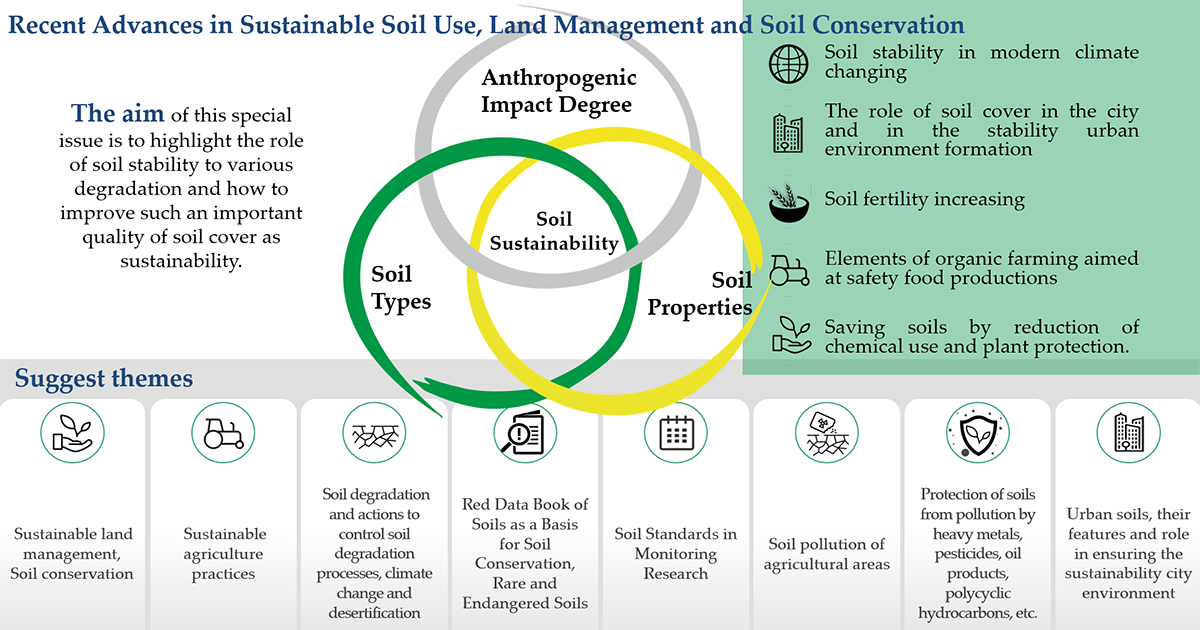Recent Advances in Sustainable Soil Use, Land Management and Soil Conservation
A special issue of Sustainability (ISSN 2071-1050). This special issue belongs to the section "Soil Conservation and Sustainability".
Deadline for manuscript submissions: closed (20 December 2022) | Viewed by 9320

Special Issue Editors
2. Laboratory for Biological Agriculture and Plant Protection, Federal Rostov Agrarian Research Center, Institutskaya 1, Rostov Region 346735, Russia
Interests: rational land use; soil conservation agricultural technologies; soil degradation and measures to combat degradation processes; climate change and desertification; the Red Data Book of soils; soil protection from pollution; soils in cities
Interests: soil organic matter; soil degradation; wetlands; soil enzyme activity
Special Issue Information
Dear Colleagues,
Sustainable soil is the key to environmental sustainability. It is determined by the properties of the soil as well as the types and degree of anthropogenic impact on the soil. The importance of the rational use of soils their protection from all types of degradation increases with the growth of the Earth's population and global warming. Some of these problems are often discussed in scientific articles. However, some of the acute problems such as soil stability in the modern era under changing climate, the role of soil cover in the cities, formation of the stability of the urban environment, elements of biological farming aimed to obtain safe products, preserve soils by decreasing chemical loads to increase the fertility and plant protection requires careful scientific attention and broader coverage of them in research publications.
This special issue aims to highlight the role of soil resilience in various types of degradation in a changing world and how to improve the quality of soil cover as sustainability.
- Suggest themes will be a valuable addition to this special issue:
- Rational Land Use, Soil Conservation Technologies;
- Soil Degradation and Measures to Combat Degradation Processes;
- Climate Change, and Desertification;
- Red Data Book of Soils as a Basis for Soil Conservation, Rare and Endangered Soils, Soil Standards in Monitoring Research;
- Assessment of the Sustainability of Soil and Land Resources, including Using GIS;
- Soil Pollution of Agricultural Areas; Protection of Soils Polluted by Heavy Metals, Pesticides, Oil Products, Polycyclic Hydrocarbons, etc.;
- Urban Soils; their Features, Role in Ensuring the Sustainability of the Urban Environment.
In this Special Issue, original research articles and reviews are welcome. Research areas may include all of the listed topics but are not limited to them.
We look forward to receiving your quality contributions.
Prof. Dr. Olga Bezuglova
Dr. Svetlana Tishchenko
Prof. Dr. Fariz Mikailsoy
Guest Editors
Manuscript Submission Information
Manuscripts should be submitted online at www.mdpi.com by registering and logging in to this website. Once you are registered, click here to go to the submission form. Manuscripts can be submitted until the deadline. All submissions that pass pre-check are peer-reviewed. Accepted papers will be published continuously in the journal (as soon as accepted) and will be listed together on the special issue website. Research articles, review articles as well as short communications are invited. For planned papers, a title and short abstract (about 100 words) can be sent to the Editorial Office for announcement on this website.
Submitted manuscripts should not have been published previously, nor be under consideration for publication elsewhere (except conference proceedings papers). All manuscripts are thoroughly refereed through a single-blind peer-review process. A guide for authors and other relevant information for submission of manuscripts is available on the Instructions for Authors page. Sustainability is an international peer-reviewed open access semimonthly journal published by MDPI.
Please visit the Instructions for Authors page before submitting a manuscript. The Article Processing Charge (APC) for publication in this open access journal is 2400 CHF (Swiss Francs). Submitted papers should be well formatted and use good English. Authors may use MDPI's English editing service prior to publication or during author revisions.
Keywords
- sustainable soil use
- soil degradation
- desertification
- soil erosion
- the Red Data Book of soils
- soil protection
- urban soils
Benefits of Publishing in a Special Issue
- Ease of navigation: Grouping papers by topic helps scholars navigate broad scope journals more efficiently.
- Greater discoverability: Special Issues support the reach and impact of scientific research. Articles in Special Issues are more discoverable and cited more frequently.
- Expansion of research network: Special Issues facilitate connections among authors, fostering scientific collaborations.
- External promotion: Articles in Special Issues are often promoted through the journal's social media, increasing their visibility.
- Reprint: MDPI Books provides the opportunity to republish successful Special Issues in book format, both online and in print.
Further information on MDPI's Special Issue policies can be found here.







